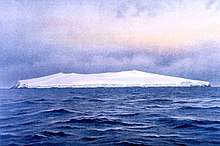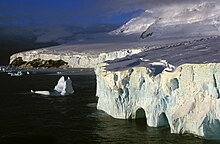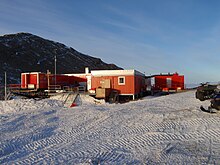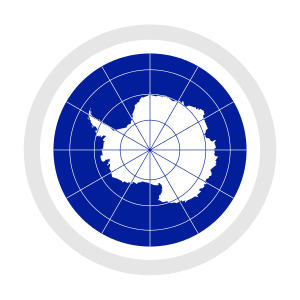Dependencies of Norway
Dependency Avhengighet | |
|---|---|
 Dependencies of Norway (red) | |
| Largest settlements | None (several active research stations) |
| Dependencies | |
| Leaders | |
| Harald V | |
• Administrators | Ministry of Justice and Public Security |
| Area | |
• Total | 2,700,203 km2(1,042,554 sq mi) |
| Population | |
• Estimate | Around 40 scientists |
Norwayhas threedependent territories(Norwegian:biland), all uninhabited and located in theSouthern Hemisphere.Bouvet Island(Bouvetøya) is asub-Antarcticisland in theSouth Atlantic Ocean.[1]Queen Maud Landis the sector ofAntarcticabetween the20th meridian westand the45th meridian east.[2]Peter I Islandis avolcanic islandlocated 450 kilometres (280 mi) off the coast ofEllsworth Landof continental Antarctica.[3]Despite beingunincorporated areas,neitherSvalbardnorJan Mayenis formally considered a dependency. While theSvalbard Treatyregulates some aspects of that Arctic territory, it acknowledges that the islands are part of Norway. Similarly, Jan Mayen is recognized as an integral part of Norway.
Both Peter I Island and Queen Maud Land are south of 60°S and are thus part of theAntarctic Treaty System.While the treaty does not affect these claims, the only states that recognize Norwegian sovereignty also have Antarctic claims.[4]The dependencies are administered by the Polar Affairs Department of theMinistry of Justice and Public SecurityinOslo,Norway's capital.[5]Norwegiancriminal law,private lawandprocedural lawapply to the dependencies, as do other laws that explicitly state they are valid on the dependencies.[6]
Government and regulations
[edit]The dependency status entails that each is not part of the Kingdom of Norway but still under Norwegiansovereignty.Specifically, this implies that a dependency can becededwithout violating the first article of theConstitution of Norway.[7]Norwegian administration is handled by the Polar Affairs Department of theMinistry of Justice and the Police,located inOslo.[5]
TheDependency Actof 24 March 1933 establishes that Norwegiancriminal law,private lawandprocedural lawapply to the dependencies, as do other laws that explicitly state they are valid in each dependency. The act further establishes that all land in the dependencies belongs to the state, and prohibits the storage and detonation of nuclear products.[8]Since 5 May 1995,Norwegian lawhas required all Norwegian activity in Antarctica, including Peter I Island and Queen Maud Land, follow international environmental law for Antarctica. All Norwegian citizens who plan activities must therefore report them theNorwegian Polar Institute,which may deny any non-conforming activity. All people visiting the area must follow laws regarding protection of nature, treatment of waste, pollution and insurance forsearch and rescueoperations.[9]
Bouvetøya has been designated with theISO 3166-2codeBV[10]and was subsequently awarded thecountry codetop-level domain.bvon 21 August 1997.[11]
History
[edit]- On 14 December 1911 five Norwegians, under the leadership ofRoald Amundsen,were the first to reach theSouth Pole.
- Bouvet Island was claimed in 1927 (formally in 1930; in 1935 the island was declared anature reserveforseals).
- Peter I Island was claimed in 1929 (formally in 1931).
- Queen Maud Land (45°E to 20°E) was formally claimed as a Norwegian possession on 14 January 1938.
- King Harald V became the first reigning monarch to visit Antarctica. He visited Queen Maud Land in 2015.
Areas
[edit]Bouvetøya
[edit]
Bouvetøya (Bouvet Island) is an uninhabited subantarcticvolcanic islandlocated in the southern end of theMid-Atlantic Ridge,either in the SouthAtlantic Oceanor theSouthern Ocean,depending on definition.[12]It isthe most remote islandin the world, approximately 2,200 kilometres (1,400 mi) south-southwest off the coast ofSouth Africaand approximately 1,700 kilometres (1,100 mi) north of thePrincess Astrid CoastofQueen Maud Land,Antarctica.The island has an area of 49 square kilometres (19 sq mi), of which 93 percent is covered by aglacier.The center of the island is an ice-filled crater of an inactivevolcano.[13]
Someskerriesand one smaller island,Larsøya,lie along the coast.[14]Nyrøysa, created by arock slidein the late 1950s, is the only easy place to land and is the location of aweather station.[15]Landing on the island is very difficult, as it normally experiences high seas and features asteep coast.[16]During the winter, it is surrounded bypack ice.[13]Theexclusive economic zonesurrounding the island covers an area of 441,163 square kilometres (170,334 sq mi).[17]
Peter I Island
[edit]
Peter I Island is a volcanic island located 450 kilometres (280 mi) off the coast ofEllsworth Landof continental Antarctica. It has an area of 154 square kilometres (59 sq mi). The island is almost entirely covered byglacier,[3]with about 95% of the surface covered by ice.[18]Surrounding the island is a 40-metre (130 ft) tallice frontand vertical cliffs.[19]The long stretches of ice caps are supplemented with rock outcrops.[18]Landing is only possible at three points, and only during the short period of the year in which the island is not surrounded by pack ice.[19]The island is ashield volcano,although it is not known if it is still active.[20]Anultra prominent peakat 1,640 metres (5,380 ft) elevation, it is named for Lars Christensen.[21]Peter I Island is the only claim between 90°W and 150°W and is also the only claim that is not asector.[22]
Queen Maud Land
[edit]
Queen Maud Land is a 2.7 million km2(1.7 million sq mi) sector ofAntarctica.[23]The territory lies between20° westand45° east,between theBritish Antarctic Territoryto the west and theAustralian Antarctic Territoryto the east. Thelatitudinallimits of the territory are not officially defined.[24]Positioned inEast Antarctica,the territory comprises one-sixth of the total area of Antarctica.[25]
Most of the territory is covered by theAntarctic ice sheet,and a tall ice wall stretches throughout its coast. In some areas further within the ice sheet, mountain ranges breach through the ice, allowing for birds to breed and the growth of a limitedflora.The region is divided into thePrincess Martha Coast,Princess Astrid Coast,Princess Ragnhild Coast,Prince Harald CoastandPrince Olav Coast.[26]Off the coast isKing Haakon VII Sea.[27]There is no ice-free land at the coast; the coast consists of a 20-to-30-metre-high (66 to 98 ft) wall of ice throughout almost the entire territory.[28]
There is no permanent population, although there are 12 active research stations housing a maximum average of 40 scientists, the numbers fluctuating depending on the season. Six are occupied year-round, while the remainder are seasonal summer stations. The main aerodromes for intercontinental flights, corresponding withCape Town,South Africa,areTroll Airfield,near the NorwegianTrollresearch station, and a runway at the RussianNovolazarevskaya Station.[29]
References
[edit]- ^"Bouvet Island".The World Factbook.Central Intelligence Agency.11 April 2012.Retrieved25 April2012.
- ^"Dronning Maud Land"(in Norwegian).Norwegian Polar Institute.Archived fromthe originalon 21 July 2012.Retrieved10 May2011.
- ^ab"Peter I Øy".Norwegian Climate and Pollution Agency.Archived fromthe originalon 14 May 2011.Retrieved29 August2011.
- ^"The Antarctic Treaty".Secretariat of the Antarctic Treaty.Archived fromthe originalon 3 June 2011.Retrieved29 August2011.
- ^ab"Polar Affairs Department".Norwegian Ministry of the Environment.Archivedfrom the original on 8 August 2011.Retrieved29 August2011.
- ^"Lov om Bouvet-øya, Peter I's øy og Dronning Maud Land m.m. (bilandsloven)"(in Norwegian). Lovdata. Archived fromthe originalon 2 December 2013.Retrieved29 August2011.
- ^Gisle (1999): 38
- ^"Lov om Bouvet-øya, Peter I's øy og Dronning Maud Land m.m. (bilandsloven)"(in Norwegian). Lovdata.Archivedfrom the original on 2 December 2013.Retrieved29 August2011.
- ^"Antarktis".Norwegian Ministry of the Environment.Archived fromthe originalon 8 August 2011.Retrieved29 August2011.
- ^Takle, Mona Takle; Vassenden, Kåre (March 1998)."Country classifications in migration statistics – present situation and proposals for a Eurostat standard"(PDF).United Nations Statistical CommissionandUnited Nations Economic Commission for Europe.
- ^"Delegation Record for.BV".Internet Assigned Numbers Authority.13 November 2009.Archivedfrom the original on 13 August 2010.Retrieved5 September2010.
- ^"Antarctic Convergence".Geographic Names Information System.Archivedfrom the original on 25 May 2024.Retrieved10 May2012.
- ^ab"Bouvetøya".Norwegian Polar Institute.Archivedfrom the original on 14 March 2013.Retrieved8 May2012.
- ^"Larsøya".Norwegian Polar Institute.Archivedfrom the original on 14 March 2013.Retrieved8 May2012.
- ^Hyser, Onno."Bouvetøya"(PDF).BirdLife International.Archived(PDF)from the original on 13 March 2013.Retrieved11 May2012.
- ^Barr (1987): 59
- ^"EEZ Waters Of Bouvet Isl. (Norway)".University of British Columbia.Archivedfrom the original on 27 January 2012.Retrieved9 May2012.
- ^abBarr (1987): 65
- ^ab"Peter I Øy".Norwegian Polar Institute.Archivedfrom the original on 29 May 2011.Retrieved29 August2011.
- ^"Peter I Island".Global Volcanism Program.Archivedfrom the original on 12 October 2004.Retrieved29 August2011.
- ^LeMasurier (1990): 512
- ^Kyviket al.(2008): 57
- ^"Minifacts about Norway 2011: 2. Geography, climate and environment".Statistics Norway.2011.Retrieved21 August2011.
- ^"Dronning Maud Land".Norwegian Polar Institute.Archived fromthe originalon 17 October 2013.Retrieved20 August2011.
- ^Mills (2003): 540.
- ^"Queen Maud Land".Encyclopædia Britannica.Retrieved25 April2011.
- ^Stonehouse: 155–156.
- ^"Dronning Maud Land"(in Norwegian).Norwegian Polar Institute.Archived fromthe originalon 21 July 2012.Retrieved10 May2011.
- ^Rubin (2008): 305.

